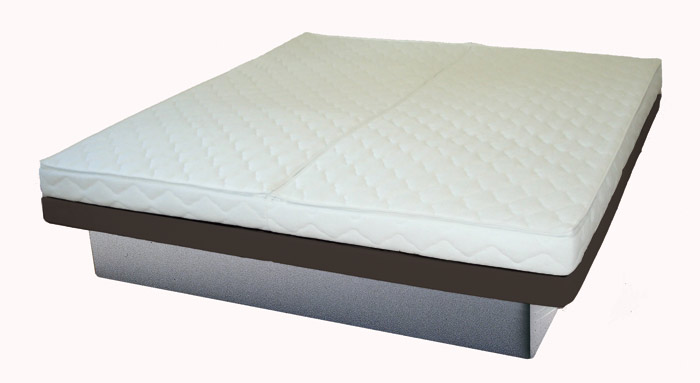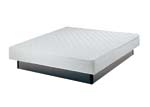Welding a special Waterbed-PVC-Foil to manufacture the watermattress.
Welding processes are often categorized and identified by the heating method that is used. All processes can be divided into two general categories: intemal heating and external heating. Internal heating methods are further divided into two categories: internal mechanical heating and internal electromagnetic heating. For manufacturing a waterbed or watermattress we produce most mattress parts by internal heating categories like Radio Frequency, Microwave and for some customers Laser technics.
There are following categories of External Heating:- Heated Tool
- Hot Gas
- Extrusion
- Implant Induction
- Implant Resistance
There are following categories of Internal Heating:
- Mechanical:
Ultrasonic
Vibration
Spin - Electromagnetic
Radio Frequency
Infrared and Laser
Microwave
External
heating methods rely on convection and/or
conduction
to heat the weld surface. These
processes include: hol tool, hot gas, extrusion,
implant mduction, and implant resist-ance welding.Internal mechanical
heating
methods rely on the conversion
of mechanical energy into heat through surface
friction and
intermolecular friction. These processes include:
ultrasonic, Vibration, and spin welding.
Internal electromagnetic heating methods rely on the
absorption and conversion of electro-magnetic
radiation into heat.
These processes include: infrared,
laser, radio frequency, and microwave welding.
Radio Frequency Welding
Radio Frequency (RF) welding, which is also often
referred to äs "dielectric
welding" is a process that relies on internal heat generation by dielectric
hysteresis losses of mermoplas-tics. It is most commonly used to weld PVC bladders
such äs intravenous drip bags for the medical industry. It is also used
to weld book and binding covers äs well äs
blister packages.
For waterbeds and parts of it we use foils
with a thickness between 0,3 and 0,7 mm.
Most good waterbeds are manufactured with
a foil of 0,5 or 0,6 mm.
Radio Frequency welding has the advantages that it is a relatively
fast process with typical cycle times of
less than 2 to 5 s. It
also does
not require any special joint
designs and produces relatively the weldings.
RF welding is almost exclusively used for welding
relatively min sheets or films. Thick-ness'
usually ränge from
0.03 to 1.27 mm, depending on the material
and the application. The welding of films is
limited because a strong
electric
field must be generated and this can only be
achieved when the welding electrodes are brought
together in close proximity,
0.03 to l .27 mm. If the welding electrodes
are significantly further apart, the electric
field density is too low to effectively heat
and melt the plastic.
Another limitation of the process is that the
material being joined must have the proper electrical
properties.
One such
property is
a relatively
high dielectric
constant, typically greater than two. This allows
more current to flow through the material, which
promotes
heating, at a
lower electrode
voltage.
The major restriction on materials to be welded
by RF is the fact that the material must have
a relatively
high dielectric
loss,
i.e., the
material
must have the
ability to convert the alternating electric field
into heat. The most common thermoplastics that
can be effectively
heated
with
RF welding
are:
• PVC
• CPVC
• Polyurethane
• Nylons (polyamide)
• Cellulose acetate
• PET, PETGA
Relatively high dielectric breakdown voltage (dielectric strength)
in the material is also important to reduce
the possibility of arcing through the material. This property is usually less
of a restriction
for material selection
with RF welding, because most plastics are
good electrical insulators and mherently have high dielectric breakdown voltage.
In some cases,
a third material can
be added to the bond Ime to allow for matenals,
which naturally cannot be heated by RF to be welded.
Joining
of Plastics and Composites for manufacturing a waterbed or Watermattress
Welding a special Waterbed-PVC-Foil to manufacture the watermattress.
Process Description of welding a waterbed or watermattress with Radio Frequency
Waterbed-Foils: Plastics and Composites for manufacturing waterbed foils
Waterbed Manufacturer ChinaBecause we manufacture the Waterbeds in China, we can offer you cheap prices for every article made of vinyl or foam. We are cheaper than some other waterbed factories in China or whole Asia, but we surely are not the cheapest waterbed manufacturer worldwide. Even if you buy our cheapest Waterbeds we try to do works like welding and cutting of the vinyl the best as we can and we have a long time knowledge in manufacturing waterbeds. We can manufacture waterbeds with the most durable foils produced by BAYER AG from Germany. ----------------------------------------------------------------------------------------------------------------------- |
|
| ------------------------------------------------------------------------------------------------------ |
|
| ------------------------------------------------------------------------------------------------------ |
Here you
will see the detailed description of the Waterbed / Watermattress articles
like Foam Rails, Mattress Covers, Waterbags and Liners, Waterbed Heaters. |
waterbed producer and manufacturer watermattress or waterbed mattress




